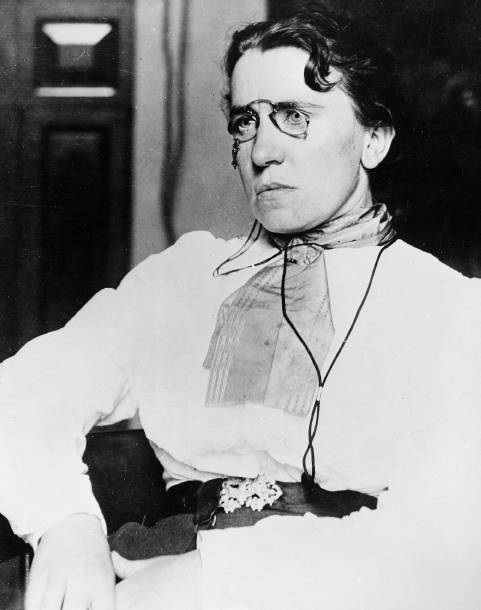The Red Scare, 1919–1920
The conviction in the Abrams case reflected broader concern over the Red scare—the fear of Communist-inspired radicalism in the wake of the Russian Revolution. Though communism failed to gain a foothold in the United States, the actions of a tiny contingent of radicals kept the threat alive and played into the hands of ambitious politicians and business leaders who wanted to crush labor agitation, which they perceived as anti-American.
Immediate postwar economic problems further increased the anxiety of American citizens, reinforcing the position of officials who sought to restore order by suppressing radicals. Industries were slow to convert their plants from military to civilian production, and consumer goods therefore remained in short supply. The war had brought jobs and higher wages on the home front, and consumers who had been restrained by wartime rationing were eager to spend their savings. With demand greatly exceeding supply, however, prices soared by 77 percent, frustrating consumers. At the same time, farmers, who had benefited from wartime conditions, faced falling crop prices as European nations resumed agricultural production and the federal government ended price supports.
A series of widespread strikes launched by labor unions in 1919 contributed to the fear that the United States was under assault by sinister, radical forces. As skyrocketing inflation undercut wages and employers launched a new round of union-busting efforts, labor went on the offensive. In 1919 more than four million workers went on strike nationwide, including those in key industries such as steel, transportation, and shipbuilding. In September, striking Boston policemen left the city unguarded, resulting in widespread looting and violence. Massachusetts governor Calvin Coolidge sent in the National Guard to break the strike and restore order.
Public officials and newspapers decried the violence, but they also greatly exaggerated the peril. Communists and socialists did support some union activities; however, few of the millions of workers who struck for higher wages and better working conditions had ties to extremists or sought to overthrow capitalism. The major prewar radical organization, the Industrial Workers of the World, never recovered from the government harassment that had crippled it during World War I. Postwar Communist parties in the United States claimed fewer than seventy thousand followers. However, scattered acts of real violence allowed government and business leaders to stir up anxieties about the Communist threat. On May 1, 1919, radicals sent more than thirty incendiary devices through the mail to prominent Americans, though authorities defused them before the mail bombs reached their intended targets. The following month, bombs exploded in eight cities, including one at the doorstep of the home of A. Mitchell Palmer, the attorney general of the United States, who emerged shocked but uninjured.
After the attack on his home, Palmer launched a government crusade to root out and prosecute Communist extremists. Like many American officials, Palmer traced the source of radicalism to recent immigrants, mainly those from Russia and eastern and southern Europe. To track down what he called the “moral perverts and hysterical neurasthenic [neurotic] women who abound in communism,” Palmer selected J. Edgar Hoover, a young Washington, D.C., lawyer, to head the General Intelligence Division in the Department of Justice. In November 1919, based on Hoover’s research and undercover activities, government agents in twelve cities rounded up and arrested hundreds of foreigners, including the anarchist and feminist Emma Goldman. Goldman, along with some 250 people caught in the government dragnet, were soon deported to Russia. Over the next few months, the Palmer raids continued in more than thirty cities. Authorities seized approximately six thousand suspected radicals from their homes and community centers, took them to police stations, interrogated them without the benefit of legal counsel, and held them incommunicado without stipulating the charges against them. Of the thousands arrested, the government found reason to deport 556. The raids failed to uncover extensive plots to overthrow the U.S. government, nor did they lead to the arrest of the bombers.

Initially, most American citizens supported the Palmer raids, but their enthusiasm quickly waned. Many came to see the violations of civil liberties that accompanied the raids as a greater threat to the nation’s traditions than the existence of a handful of American Communists. In 1920 a group of pacifists, progressives, and constitutional lawyers formed the American Civil Liberties Union (ACLU) to monitor government abridgments of the Bill of Rights. Although the Palmer raids ended, the Red scare manifested itself in different forms throughout the 1920s. After J. Edgar Hoover became director of the Bureau of Investigation (later renamed the Federal Bureau of Investigation) in 1921, he continued spying on suspected radicals, collecting information on a variety of Americans, and increasing his power over the next several decades.
Compounding the anxieties fueled by the Red scare, a medical crisis plunged Americans into panic. In late 1918, just as World War I was ending, an influenza epidemic struck the United States. Part of a worldwide contagion, the disease infected nearly 20 percent of the U.S. population and killed more than 675,000 people. Soldiers returning home from the war brought the flu virus with them. Infants and the elderly succumbed, as well as able-bodied young men and women. As the death toll mounted over the course of 1919, terror gripped the nation. Susanna Turner, a volunteer at an emergency hospital in Philadelphia, recalled: “The fear in the hearts of people just withered them. They were afraid to go out, afraid to do anything. If you asked a neighbor for help, they wouldn’t do so because they weren’t taking any chances. It was a horror-stricken time.” A staggering 50 to 100 million people worldwide are estimated to have died from the flu before it subsided in 1920.